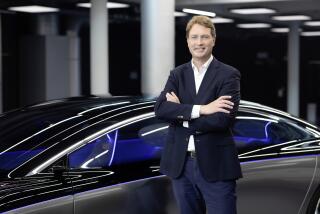German Car Buyers’ Favorite Pickup
- Share via
WOLFSBURG, Germany — Granted, climbing into a ride that replicates a rollover accident is probably not every buyer’s idea of what to do while waiting for a new car to be delivered.
But don’t tell that to the people in line for the simulator, or the kids buzzing around in the miniature Volkswagen Beetles, or the technology buffs glued to the video display about fuel injection engines.
Here, Germans’ nationally revered act of going to the factory to pick up a new car has been transformed into a deluxe celebration that can last a day or weekend, a la an American trip to Disneyland.
“For Germans, buying a new car is a big event,” says Maria Schneider, creative director of the VW Autostadt theme park, the second most popular amusement park in the country. “The car is part of the family, like the children.”
Traveling to the factory to receive the car rather than going to the local dealership where it was ordered is a tradition here. Other major manufacturers, such as DaimlerChrysler, BMW and Porsche, offer their car-fetching visitors guided tours of their assembly plants and one-on-one customer service at the time of collection.
But VW has elevated a practical undertaking into a life experience. An hour by train from Berlin and a pleasant five-minute walk from the station is the $450-million Autostadt, German for Auto City. Amid a Disney-like panoply of exhibits, rides and restaurants, Autostadt’s 6,000 daily visitors each spend an average of 4 1/2 hours absorbing the latest motor trends, strolling among man-made lakes and landscaped pavilions and taking virtual-reality test drives.
Though Autostadt is proving popular with VW buyers, the bulk of its patrons are Germans simply out for a jaunt. From school field trips to the annual office outings that are another unique national habit, the theme park draws three times as many visitors on average as Berlin’s historic, glass-domed Reichstag.
“We read about it when it opened but only got around to visiting now,” said Cindy Woop, a 23-year-old tax advisor from Cologne who tried out the rollover accident simulator, which demonstrates how seat belts and head rests protect a driver. “It’s interesting. It gets you thinking about things you take for granted.”
The centerpiece of the theme park is the car pickup center, a cavernous hall combining the light and space of an airport terminal with the atmosphere of a celebrity hangout. Car buyers are summoned to one of three runways by an elevated futuristic signboard that flashes their names, dealerships,license-plate numbers and collection appointments in luminous lime-green letters. In a rare moment for Germans when the customer is truly king, the buyer’s entourage is then escorted down a broad staircase to the collection level and encouraged to go over the shiny new purchase with a fine-toothed comb.
Nearby, a uniformed delivery specialist with nearly three years’ training stands with an electronic clipboard, ready, able and willing to answer any and all questions the buyers might have for as long as they want to prolong the occasion.
Delivery specialist Tatiana Vanella says that most customers’ questions are covered in the thick owner’s manuals provided with each new car but that many want a personal demonstration of how the air-conditioning system works or tips on how to best protect the finish.
“We have to know everything about the cars. That’s why we train so long,” said Vanella, a Wolfsburg native who just graduated from the post-sales school in January.
Each proud new automotive parent spends an average of 70 minutes in the delivery room, says Autostadt spokesman Nicholas Batten. By contrast, it is rare in Germany for soon-to-be fathers to spend any time at all in the room while their wives are delivering babies.
On a recent day, retired machinist Wolfgang Lechner stepped up to the receiving stage to take possession of his poppy-red Golf diesel. He and son Stefan had spent a few hours puttering around the antique car museum and new technology exhibits before their appointment with delivery specialist Enrico Behrens.
“I think I’ll be happier with this hatchback now that I’m retired,” said the elder Lechner while his son poked under the hood as they got ready for the five-hour drive home to Kempten. “I had a BMW sedan until now, but it’s getting to be too much of a struggle to get a case of beer into the trunk. With this car, I can slide it in and out more easily.”
Dirk and Monika Pilarski, collecting their Golf station wagon on the same day, lauded the attention lavished on 6-year-old son Simon, who even after five hours was protesting his parents’ entreaties that they head home.
“There’s a lot for kids to do with their hands and a lot of stuff that gives them a sense of being a grown-up,” Monika said. “The whole child-care center is designed to keep the kids busy so the adults can enjoy and inform themselves.”
Miniature electric-powered Beetles allow children as young as 5 to motor around an outdoor test track after a 15-minute instruction film and “exam” on the rules of the road. Successful passage of the easy test on stop signs and seat belts qualifies a child for an official-looking driver’s license complete with photo that is good on the electric-car grounds of the Autostadt. Child-care professionals look after youngsters up to 3, and a center well-appointed with things on wheels takes care of those older but still too young for the road test.
With such amenities, the nearly 2-year-old Autostadt is drawing at least twice as many visitors daily as marketing gurus envisioned when they came up with the idea seven years ago. Admission is free for the roughly 500 buyers who arrive each day to claim their cars. It is also free for as many family members and friends as they have in tow, but other visitors must pay the equivalent of about $8 for an adult and $5 for a child. That has made the theme park, which employs 1,800 people, far less of a drain on the company’s marketing budget than designers expected. Autostadt generates enough income to finance continuous refinement and expansion, Schneider says.
While infatuation with cars is widely regarded as a guy thing,Autostadt’s administrators say the park’s primary target is women.
“In German families, it’s the women who make the choices about what kind of car to buy, what color it should be, how much trunk space is needed,” says corporate communications officer Silke Schumacher. “It’s usually the wife who does the most driving, so she has the most influence in the decision.”
Going to the factory to get the car seems to be a peculiarly German practice, an ingrained consequence of consumers’ fixation on authenticity and elaborate preparation, Autostadt chief executive Otto Wachs says.
“Europeans in general and Germans in particular are more focused on the process of buying a car than are Americans,” Wachs says. “They think for a long time about what they want in a car, draw up a list of the options they will order and often wait months for their car to be completed. They don’t go to a dealership and say, ‘Hey, this yellow one appeals to me’ and have it home in the garage two hours later.”
Decision-to-delivery does take an amount of time that U.S. consumers would probably find unacceptable. But anticipation is part of the attraction here. Most of those collecting their cars in early April ordered them before Christmas.
“I didn’t want it any earlier. I wanted to come during the Easter break so the kids could come along,” said Werner Seidel, a divorced father from Bavaria who was Autostadt’s 4-millionth visitor. Feted with cake and champagne and photographed for local media and company promotions, Seidel shared the limelight with his father, Edi, 9-year-old daughter, Lisa, and 12-year-old son, Jochen.
While Autostadt’s administrators estimate that they probably sell about 1% of their daily visitors on the idea of eventually owning a VW or sister product from Audi, Skoda, Seat, Bentley or Lamborghini, it is not possible to buy a car at the theme park. Wachs says the Autostadt experience should enhance the brand image of Europe’s No. 1 car maker rather than undermine the time-tested relationship between local dealers and consumers.
In fact, an Autostadt visit to get the car is one of the incentives a dealer can offer to a prospective buyer. Reduced rates at the on-site Ritz-Carlton Hotel and its Michelin-starred restaurant are available, as well as the opportunity to avoid more than $400 in delivery taxes. Such benefits make it cost-effective to make the pickup in person.
Getting the car is a ritual that begins with the buyer’s taking license plates acquired from local authorities to a reception office above the piazza where post-sales personnel set in motion the hand-over that can run the whole day if a customer so desires. The names of all members of the collection party are radioed to VW colleagues at each stop on the pickup itinerary, and the precise, long-agreed-upon time for the ceremonial hand-over is confirmed. While the buyer’s party is perusing the exhibits, simulators, games and gastronomic offerings, the relevant car--earlier shuttled from the adjacent factory to the theme park’s twin 20-story storage towers--is moved to the delivery room of the pickup center for final polishing, plate attachment and inspection.
Collecting a car at the factory is a practice currently limited to German buyers because of European Union tax and customs rules, but changes within the economic bloc will make it possible for Austrians to take part in the Wolfsburg experience by summer. For potential buyers from outside the EU--say, an American wanting a car at the start of a European trip--a hand-over can be arranged with sufficient notice, says Batten, the Autostadt spokesman.
Departing customers get two route maps for their outbound journey--one the most direct, the other taking in scenery and attractions--along with little extras like windshield scrapers and dashboard sun shields. Any purchases from the Autostadt’s three car-equipment shops, which sell everything from floor mats to picnic baskets, are loaded into the trunk along with luggage checked at the train station, so the new car owner can drive home without stopping.
What happens if the buyer fails to show up during the mere handful of minutes his or her name is flashed on the signboard?
“Germans don’t miss their appointed times,” replied Batten, clearly shocked by the suggestion. “On the rare occasion when people get delayed by the unexpected, they call ahead to warn us. This is something they take very seriously.”







